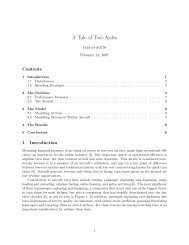Neural Models of Bayesian Belief Propagation Rajesh ... - Washington
Neural Models of Bayesian Belief Propagation Rajesh ... - Washington
Neural Models of Bayesian Belief Propagation Rajesh ... - Washington
Create successful ePaper yourself
Turn your PDF publications into a flip-book with our unique Google optimized e-Paper software.
11.5 Discussion 253<br />
an evidence accumulation process similar to computing a log-likelihood ratio<br />
over time (see section 11.4.2). Gold and Shadlen develop a mathematical model<br />
[12] to formalize this intuition. They show how the log-likelihood ratio can be<br />
propagated over time as evidence trickles in at each time instant. This model is<br />
similar to the one proposed above involving log-posterior ratios for decisionmaking.<br />
The main difference is in the representation <strong>of</strong> probabilities. While<br />
we explicitly maintain a representation <strong>of</strong> probability distributions <strong>of</strong> relevant<br />
states using populations <strong>of</strong> neurons, the model <strong>of</strong> Gold and Shadlen relies on<br />
the argument that input firing rates can be directly interpreted as log-likelihood<br />
ratios without the need for explicit representation <strong>of</strong> probabilities.<br />
An extension <strong>of</strong> the Gold and Shadlen model to the case <strong>of</strong> spiking neurons<br />
was recently proposed by Deneve [8]. In this model, each neuron is assumed<br />
to represent the log-“odds” ratio for a preferred binary-valued state, i.e., the<br />
logarithm <strong>of</strong> the probability that the preferred state is 1 over the probability<br />
that the preferred state is 0, given all inputs seen thus far. To promote efficiency,<br />
each neuron fires only when the difference between its log-odds ratio and a<br />
prediction <strong>of</strong> the log-odds ratio (based on the output spikes emitted thus far)<br />
reaches a certain threshold.<br />
<strong>Models</strong> based on log-probability ratios such as the ones described above<br />
have several favorable properties. First, since only ratios are represented, one<br />
may not need to normalize responses at each step to ensure probabilities sum<br />
to 1 as in an explicit probability code. Second, the ratio representation lends itself<br />
naturally to some decision-making procedures such as the one postulated<br />
by Gold and Shadlen. However, the log-probability ratio representation also<br />
suffers from some potential shortcomings. Because it is a ratio, it is susceptible<br />
to instability when the probability in the denominator approaches zero (a log<br />
probability code also suffers from a similar problem), although this can be handled<br />
using bounds on what can be represented by the neural code. Also, the<br />
approach becomes inefficient when the number <strong>of</strong> hypotheses being considered<br />
is large, given the large number <strong>of</strong> ratios that may need to be represented<br />
corresponding to different combinations <strong>of</strong> hypotheses. Finally, the lack <strong>of</strong> an<br />
explicit probability representation means that many useful operations in probability<br />
calculus, such as marginalization or uncertainty estimation in specific<br />
dimensions, could become complicated to implement.<br />
Inference Using Distributional Codes<br />
There has been considerable research on methods for encoding and decoding<br />
information from populations <strong>of</strong> neurons. One class <strong>of</strong> methods uses basis<br />
functions (or “kernels”) to represent probability distributions within neuronal<br />
ensembles [1, 2, 9]. In this approach, a distribution P (x) over stimulus x is<br />
represented using a linear combination <strong>of</strong> basis functions:<br />
P (x) = <br />
ribi(x), (11.46)<br />
i
















